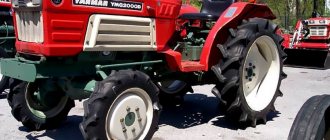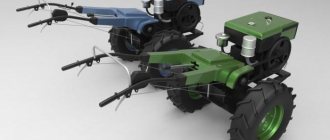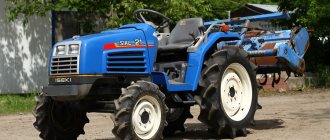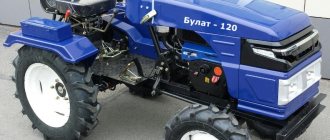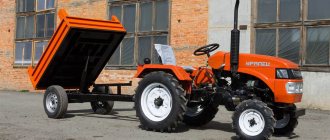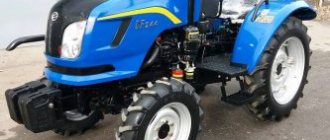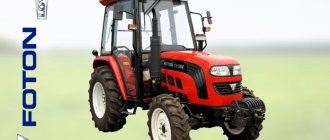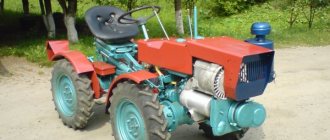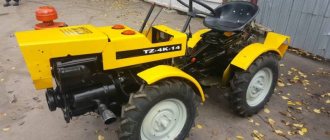Description
ISEKI mini tractors are produced by a Japanese company that began producing agricultural machinery in 1927. By constantly modifying equipment and using new technologies, the company sought to significantly facilitate the farmer’s work in the field. Having gained popularity due to the quality of the units produced in their homeland, Iseki’s leaders gradually expanded the sales market.
In 1991, the brand management entered into an agreement with the large manufacturer Massey Fergusson for the supply of engines and spare parts. The high-torque, working units that came off the assembly line coped with the assigned tasks perfectly.
The produced models did not become the limit of development, so after 2 years, together with the Perkins company, specializing in the production of diesel engines, a new improved series of “D” engines appeared. Thanks to this cooperation, the Iseki company began to produce equipment with its own engines, which were distinguished by quality and efficiency. Iseki's company also produces custom vehicles, partnering with major manufacturers such as Challenger. This is the world famous Caterpillar series.
The Russian market is familiar with the Iseki company thanks to mini tractors that help increase the efficiency of tillage of any soil, are easy to operate and are equipped with reliable mechanisms.
The price of new units starts from $4300 to $7500. On the secondary market they are approximately 2 times cheaper.
Advantages of ISEKI tractors
As a result of many years of operation of ISEKI tractors, the equipment has shown its best side. It has the following advantages:
- It is possible to use attachments both at the rear and at the front.
- The axle designs have been improved, thanks to which ISEKI mini tractors have a small turning radius and excellent maneuverability on the ground.
- Small size and light weight of the unit.
- Everything is provided for the driver’s comfortable stay in the cabin: air conditioning, heating system, ergonomic control panel and a comfortable seat.
- Availability of power steering.
- Noise and vibration levels are significantly reduced, allowing the driver to be less tired after a work shift.
Advantages and disadvantages
Over the past decades, branded Kubota tractors have proven themselves to be the best in all areas of application.
- The owners noted the successful layout of the equipment, which does not exclude easy access to adjustment and adjustment points, filling necks and docking points.
- Due to its excellent traction parameters, the minitractor is suitable for towing trailers and carts weighing 2.5-3 tons on country roads with difficult terrain and hard surfaces
According to user reviews, the first place in the list of shortcomings is the high cost of the tractor and the entire repair and restoration range of spare parts.
Video: B2420 in action
Model range of ISEKI tractors
Conventionally, the model range of ISEKI tractors can be divided into the following series:
Iseki TXG
Currently, the lineup consists of one model, the TXG237, which has compact dimensions, 27 hp engine power and a high level of maneuverability, providing the ability to turn around in a small area of soil.
The mini tractor is designed to perform a wide range of functions, but in most cases it is used by municipal farms for work in parks and courtyard areas. Supports mounting of various attachments such as bucket, blade, lawn mower and more.
Iseki TM
This series consists of lightweight mini tractors of small sizes. Their motor power can vary from 16 to 25 hp. Thanks to this range, mini tractors are successfully used to perform both complex earthworks in agriculture and light landscape functions.
All models are very popular due to their successful design, ease of use and easy access to the engine compartment. The high level of comfort for the driver, which is ensured thanks to the ergonomic cabin, makes Iseki mini tractors very popular and in demand all over the world.
Iseki TH
The TH series is a powerful one, as the models are equipped with diesel, three-cylinder engines with power from 24 to 33 hp. In such machines, water cooling is installed. The advantages of the models are the presence of all-wheel drive and disc brakes. Moreover, all equipment is easy to repair, and parts are freely available in the dealer network.
The units are used in a wide variety of areas, but mainly over large areas.
Iseki TF
The TF series is designed to perform complex agricultural work, such as, for example, work in rice fields. Depending on the model, specifications may vary. Some have all-wheel drive, while others only have front-wheel drive.
Engine power is within 27 hp. But all models in this series are equipped with three-cylinder diesel engines. The cabins are quite spacious and comfortable. They provide air conditioning in the summer and heating in the winter.
Iseki TG
The peculiarity of the series is that some models of Iseki mini tractors have a full-fledged driver’s cabin, while some are produced without it. Technical characteristics also vary: diesel engine power varies from 33 to 50 hp, water cooling is provided, and the number of cylinders can be three or four.
Designed to perform work of increased complexity, therefore the front and rear axles are reinforced. The transmission is with three levels, and the gearbox has 12*12 speeds. Multi-disc brakes and power steering are used to enhance maneuverability.
Iseki TJ
A professional series of mini tractors that are equipped with four-cylinder diesel engines with power starting from 75 hp. Only water cooling is provided, because the units can operate with increased loads in difficult areas under various operating modes.
The machines have reduced noise and vibration levels. And modern engines consume little fuel.
Iseki TJW
This series of tractors is classified as professional, as they are equipped with diesel engines with power from 95 to 105 hp. Thanks to large wheels with high tread, Iseki tractors have good maneuverability. The equipment is distinguished not only by its modern design, but also by the use of the latest developments in the field of mechanical engineering. Built-in automatic systems independently select the driving mode and adapt to the type of soil, while consuming fuel economically.
The TJW series is adapted to work on any surfaces and soils of any complexity. These cars are not afraid of bad weather either. With the ability to use a variety of equipment, they can perform a wide range of jobs.
Serie B
All-wheel drive devices are actively used by both commercial organizations and individuals. Often, Kubota mini tractors of this series have diesel engines, the power of which can reach 32 horsepower.
Recently, the device has been used in limited areas, such as gardens, vineyards, construction sites and greenhouses. The compactness, economy and maneuverability of Japanese mini tractors of the B series contribute to the fact that landscape designers often improve the territory with their help.
Kubota B2420
All components and technological units are of Japanese origin, so there is no doubt about the reliability of the “assistant”.
Specifications:
- Engine – Kubota D1105-E2-D22T;
- Power – 24 l. With.;
- Load capacity of the rear mount – 615 kg;
- Transmission – 9 front, 3 rear;
- Steering – integrated power steering;
- Speed – 18.8 km/h;
- Weight – 695 kg.
Many owners of this model are satisfied with their choice, since it copes with its tasks perfectly, does not fail, starts quickly and, with proper care, can serve for quite a long time.
Brief overview of equipment for ISEKI mini tractors
The range of attachments with which the Iseki mini tractor can be mounted is very diverse. The hydraulic system is designed in such a way that it allows lifting up to 1 ton of various loads. This makes machine models in demand in the agricultural market. But when choosing equipment, you need to know that you can only install original equipment, directly from the same manufacturer.
The range includes:
- Potato planters/diggers;
- Harrow;
- Leaf collection device;
- Rotary mower, blade, hiller, plow, cutter;
- Tow hitch;
- Garden spraying device;
- Brush;
- Lawnmower;
- Front loader.
The photo shows a three-point hitch mounting system using the example of an Iseki TU-1700 F tractor
User manual
Japanese Iseki mini tractors are adapted for the Russian market, and therefore are durable. Manufacturers promise many years of trouble-free operation, subject to compliance with operating rules, proper maintenance and regular maintenance.
When starting the engine, you should not force the starter to operate for more than 10 seconds. Before operation, the engine must be warmed up at a speed of 1500 rpm for 5 minutes. The cars use diesel fuel. SAE 10V30 should be used as engine oil, MGE 46V for transmission, and SAE80 for hydraulic system.
It is recommended to replace the lubricant in the engine after 100 hours of operation. The air filter requires increased attention, so it is checked after 50 hours of operation, and after 400 hours the air purification filters are replaced. After 950 hours of operation of the tractor, it is necessary to carry out major maintenance. More details about operation are written in the instructions.
The link to the instructions is provided below
Basic malfunctions and ways to eliminate them
Despite the fact that Japanese technology is famous for its quality and durability, problems can sometimes occur.
- There is no transmission of torque by the clutch. To do this you need:
- Adjust the pedal stroke;
- Replace/clean disks;
- Check and eliminate disc deformation.
- Attachment does not lift:
- Check the amount of oil in the system;
- Turn on the pump;
- Check the operation of the safety valve.
- Poor brake performance:
- Adjust the free play position of the brake pedal;
- Replace the brake pads.
- Transmission temperature increases:
- Adjust the gear clearance;
- Add oil to the transmission or replace it with a higher quality one.
Iseki mini tractor
Iseki & Co.Ltd. known as a manufacturer of high-quality equipment for almost 100 years. Since the sixties, it has been producing tractors, which are sold all over the world under various famous brands Massey Ferguson, Bolens, AGCO.
Japan has long been the world leader in the production of mini-equipment. It is the Japanese mini-tractor, as the smallest machine, that is included in the Guinness Book of Records. Thanks to their high reliability and exemplary build quality, Japanese Iseki mini tractors are extremely popular in agriculture and construction.
The beginning of the Kubota tractor brand
The company was founded in 1890, when the production of cast iron pipes for water supply was established in the city of Osaka (Japan). A complete change of activity by the company was carried out in 1920. At that time, Kubota began to develop and produce power plants running on kerosene.
The thirties of the last century were marked by the popularization of diesel engines. Accordingly, the company switches to producing similar equipment. The year 1947 had an impact on the formation of the Kubota company. During this period, the company produces a cultivator capable of cultivating the soil. Agricultural workers appreciated the product, the future fate of the company was predetermined, already in 1960 the first classic tractor was developed and put into production.
The date when the Kubota minitractor was born is the year 72. Feature of the model: 4-wheel drive. For that time, such technology was available only to the United States of America, and only full-fledged machines were produced.
Today, the company's branches are distributed throughout the world. Small tractors are popular among both farmers and workers. Lightweight, compact, productive cars ply the streets of hundreds of cities, and this is thanks to the founder, the Kubota brand.
Model range overview
Several dozen models of mini tractors have been developed, which are represented in the following series:
Features of Iseki mini tractors:
- Versatility and wide functionality.
- Economical fuel consumption.
- Comfortable operation, which is ensured by an ergonomic design and power steering.
Like other Japanese mini tractors, Iseki has a complex design; the latest achievements and modern technologies are used in production. Naturally, such technology cannot be cheap. The cost of new Iseki mini tractors, depending on the modification, ranges from $4300 -7500.
Japanese Iseki mini tractors are very reliable and durable; in price they occupy an intermediate position between budget Chinese cars and expensive models from European brands.
Used equipment can be purchased 2-2.5 times cheaper. However, there is a nuance - the older the car, the less likely it is to find the necessary spare parts. It is possible that they will have to be shipped from Japan, which will cost significantly more than original parts for newer models.
TXG Series
Iseki TXG 237 mini tractor with 27 hp power. - the only model in its subgroup, it is very popular.
The compact, maneuverable unit is widely used in the agricultural sector, construction, and municipal organizations; it is perfectly combined with a variety of additional mechanisms. The warm cabin allows you to work in the machine in any weather conditions.
TH and TM series
The TH and TM series are represented by machines with an engine power of 16-25 hp, used in the agricultural sector and landscape design. Convenient access to working units and mechanisms is the main difference between the modifications.
TU Series
The Iseki TU series mini tractor is the popular Iseki TU175 model with an engine power of 17.5 hp, an indispensable assistant in the garden. Model TU 177 is equipped with a large soil tiller and has a canopy.
Video review of the Iseki TU175 mini tractor
TF Series
The Iseki TF series is equipped with three-cylinder diesel engines of 27 hp. The presence of a spacious heated cabin allows you to operate mini tractors in difficult areas and in difficult conditions. All-wheel drive or front-wheel drive models are available.
TG Series
Iseki TG mini tractors are distinguished by higher engine power of 30-50 hp, high maneuverability, optimal maintainability, multi-disc brakes, three-level transmission and power steering. One of the most popular models is the Iseki TG5470 (46 hp).
TJ and TJW series
The Iseki TJ and TJW models represent a group of powerful special equipment. Professional machines have four-cylinder engines of 75-105 hp, and numerous attachments are rationally connected to them.
Reviews of Japanese used mini tractors
Repeating ourselves and returning to the rather interesting topic of Japanese mini tractors, which are usually used, since new ones are not available to everyone, I would like to note and remind you that they all have quite a lot of operating hours.
Consequently, many mini tractors imported from Japan require the replacement of some parts, repairs and routine maintenance. All of you, of course, understand this and the fact that it does not have a guarantee and spare parts for it cost the same as for a new mini tractor. But maybe someone produces similar spare parts. But sometimes no one knows this. Selling used mini tractors is not a new topic. They are also sold in Europe, but with pre-sale preparation. In Germany, such tractors are repaired, the engine is checked and they are repainted. Well, as usual, we have it straight from the fields and cheaper. However, if there are such tractors in Europe, then spare parts can be found for them. True, the price will be biting. This means you need to take care in advance and find out where you can get it repaired. In essence, you are buying from unknown sellers, a pig in a poke, and you will be able to buy equipment that is of little use for use or repair. It is necessary to understand that Japanese mini tractors are quite complex machines and many who buy them cannot figure out the control knobs. Plus, it's difficult to read about them in Japanese. Without knowing the instructions for use, many make various mistakes that lead to breakdowns. Also think about maintenance, because you will need oil, fuel and air filters. Many adapt similar filters that we already have. We advise that when buying a used tractor, remember the problems with old foreign passenger cars. When older cars were sold because they were old, but serviceable, and new ones were sold finished and in need of major repairs. We hope that the collected reviews from the owners will clarify your considerations and you will make the right choice:
03/05/2013, Zheleznogorsk “The “good uncle” (he would have hanged him by the scrotum) brought me a kubota L1-245. Brief description: a bunch of Japanese scrap metal, it actually starts and even drives! I won’t talk about the front camera, which is in disarray, though. can anyone tell me? sometimes it works great, but suddenly it starts slowly, after some time it’s back to normal. But at the moment I am confused by another problem: the rear linkage (mill) jerks up and down almost all the time and has stopped raising all the way. Someone please take pity and advise a novice tractor driver.
03/05/2013, Artyom, Primorsky Territory. Boris Greetings to all tractor owners! Before the New Year I purchased a Yanmar Ym 1700 D mini tractor. everything seemed to be nothing, but I ran into a problem, I couldn’t find a filter for my tractor. I got out of the situation like this! 1. An airy one from a VAZ (costs a penny) cut and installed. 2. oily. I put a spacer under the oil filter and immediately picked up a car filter in the store. Since there were holes for sensors, I installed them from a UAZ with an indicator and an additional emergency one. 3. Fuel. There was a sump filter, I had to remove it and install a regular one. QUESTION for owners of tractors whose engines are NOT EQUIPPED WITH A WATER PUMP AND THERMOSTAT. HOW DO SUMMER BEHAVIOR UNDER LOAD? ARE THEY NOT WARM? DOES THE ENGINE OVERHEAT LIGHT GO ON?
02/21/2013, Kostanay. Ruslan Good day! I bought myself an ISEKI TU 1700F tractor. Something bad happened and the engine overheated. They brought it to the hangar and started disassembling it, the men said it was most likely the pump. We got to the pump and removed it. It turned out that the impeller broke due to overheating. Well, I think I’ll order it, I called the guys from whom I ordered the tractor, they say you won’t find the impellers separately, order the pump. And the pump is not cheap. I would like to ask you if it is possible to pick up some kind of pump from Japanese cars that is identical to this one, or at least more or less suitable for this one. Thanks in advance, I hope for your help.
November 21, 2012, Irkutsk. Andrey The fact of the matter is that there were no problems with Iseki, and therefore there was no need for spare parts either. I brought it through a company from Japan in 2007, at that time there was no tractor boom, only a few were imported. He had a full pre-sale. The paint was a little peeling (original), but over the years of use it didn’t get any worse (I never touched it up). The equipment that I plan to take is fresher than my TU1700. I understand about the reliability of Iseki and Kubota. I think I can decide by personal comparison. Kubota X-20 is already in Irkutsk, and Iseki TG-21 is on its way from Japan. Try the possibilities of one and the other. The power is almost the same, with the Kubota with 4 cylinders producing 20 HP and the Iseki with 3 cylinders producing 21 HP. The X-20 likes the accelerated turn function (without pressing the brake pedal). As for the TG -21, I don’t know whether it has such a function or not. I’ll wait until Iseki arrives and determine it there, but in the meantime I’ll look for comparative characteristics on sites, maybe I’ll find something or someone can tell me.
03/10/2012, Kremenchug, Poltava region. Yanmar1401D Dear colleagues, I have a question. The rubber on the rear has already worn out, or rather is starting to crack on the sides. I want to buy something new, but bad luck. My original Bridgeston size: 8.00 - 16. I've looked all over the internet and can't find this size. Maximum 7.50 - 16. You can choose low-profile ones, but I don’t know the outer diameter of the new native slopes. I realized that the inch designation with a zero at the end means the tire profile height is about 92%. I figured it out using the formula: a tire 8.00 - 16 has an outer diameter of approximately 824mm. At the moment the existing outer diameter (of my worn ones) is 765mm. So they are tormented by doubts about what to buy. There are low-profile Goodyear tires 280 x 70 R16, outer diameter 805mm. Maybe someone has the opportunity to measure or find out the exact outer diameter of the tire 8.00 - 16, I would be very, very grateful. PS Another surprising thing is that the front tires were Bridgeston 5.00 - 12, they also cracked two years ago and were replaced with KAMA 6.00 - 12. And it turns out that the completely bald (the tread has worn off almost completely) Japanese 5.00 - 12 are 8 millimeters smaller in outer diameter than Russian 6.00 - 12. And if you take into account the tread height (around 50mm). I don't understand anything.
05/29/2009, Moscow I bought a Kubota ZB7000 mini tractor, but there is little information from owners of similar equipment. I took my little tractor from Vladivostok (Japanese) and only last week I got around to testing it before taking it to the village. Considering that this was the first time I was operating a tractor, the result was impressive! I milled 1.5 acres of heavy celena in 15 minutes. but there is also a negative point, during work I noticed that the front right wheel was wobbly and jammed. I took off the wheel and found that there was a hole in the wheel gearbox cover and the hub was loose. Further disassembly showed a complete absence of balls in all 4 bearings of the gearbox and complete rusting of this unit - well, the eyes are afraid, but the hands do! I've almost assembled it, I'm waiting for the seals, they promised to do it next week. It would be interesting to collect statistics on what broke and who broke it, Japanese owners, please respond. In my unexperienced opinion (but an engineering one), this little tractor is still quite universal. I think the problem with water is that the Japs are crawling in the rice paddies in the water! but thanks for the warning, I’ll definitely get into the diff and the second gearbox. But I don’t have an electric pump on the tractor; the oil flows by gravity through the filter into the fuel injection pump, although I’m not 100% sure (I didn’t really look at it). Yes, if you are interested, I can send you a repair manual for the 6000, with catalog numbers of spare parts. The truth is that in Khabarovsk the spare parts are probably simpler. In Moscow, I haven’t found where to get spare parts yet, so far the gearbox has been treated with oil seals and bearings, the gears and shafts, although rusty, are intact and not broken. Of course, it was not very easy to disassemble, but I managed! And the link in the first post, a Belgian asks for 350 euros for a gear, probably ate something. Ordering from the factory is not a problem, but as a rule they take a long time.
2.06.2009. Kirovograd region I’ve had a 6000 (different engine and 2″ smaller tires) for about 15 years now. The entire front end also had to be shaken up at once, and not just the side ones - a consequence of the presence of water. As far as I know, this is a fairly common problem. Well, the engine - out of stupidity... Oh, and the electric control unit also grunted. pump - such a fitniflushka-microcircuit on the case. Nothing else broke. If you're not too concerned about versatility, this is a good choice. The machine is quite reliable and unpretentious.
06.06.2009, Irkutsk I have a Kubota B5000 in operation. This is the second year I’ve been working at the garden – it’s just lovely (small, convenient, you can drive everywhere and turn around). The kit included only a cutter. Today I made a double-body plow - it touches my dear soul, it was possible to hang a third body. Now I’m working (albeit on paper for now) on making a potato digger. Question for the owners of Japanese mini tractors: what kind of oil should be poured into the box, since it contains the rear axle gearbox and hydraulics?? According to the manual there should be a Kubota UDT, but we have nowhere to get it. Who is pouring what?
Attachments
Iseki mini tractors are combined with a variety of mounted agricultural and municipal equipment. Thanks to the reinforced hydraulic system, the load capacity of the units can reach 1000 kg. A number of models of Iseki mini tractors have the ability to connect only “native” attachments, which should be taken into account when purchasing.
To connect mounted units, a three-point hitch is used, as shown in the photo of the Isek TU-1700F mini tractor.
Some models of tillers have a two-point hitch, which is not suitable for other equipment. Therefore, to connect other units, an additional attachment must be installed.
Video review of the operation of an Iseki mini tractor with a trailer
Video review of the operation of the Iseki TU-155 mini tractor with a blade
Specifications
Dimensions:
- length – 2150 mm;
- width – 960 mm;
- height – 1750 mm;
- wheelbase – 1165 mm;
- front track width (adjustable) – 980-1190 mm;
- rear track width (adjustable) – 1050-1250 mm;
- minimum turning radius – 2800 mm;
- ground clearance - 250 mm.
The operating weight of the minitractor is 475 kg, the load capacity is 500 kg. special equipment is capable of moving at speeds of up to 15 km/h. The processing width is 1000 mm.
User manual
Iseki mini station wagons have high technical performance. A machine with an average power of 16-18 hp. is able to easily perform work that can be done by its Chinese counterpart with significantly more power - at least 25 hp.
Iseki mini tractors are undoubtedly associated with the highest level of quality, which is achieved through the introduction of innovative technologies and exemplary control over production.
The durability of parts and assemblies of Iseki mini tractors, impeccable performance characteristics, long working life are the distinctive characteristics of Iseki mini tractors. Therefore, equipment of this class is extremely demanding for systematic preventive maintenance and timely repairs.
Service
The Iseki minitractor consumes diesel fuel. Under the hood of each tractor there is a sign with recommendations regarding routine maintenance. For engine oil, a replacement period is set after 100 hours of operation, and a systematic check is every 5 engine hours. Iseki mini tractors operate on semi-synthetic diesel oils: SAE 10V30 for the engine, MGE 46V for hydraulic displacement transmissions, SAE 80 for hydraulics and steering gear.
The condition of the air filter is checked every 50 hours of operation, and after 400 operating hours the air cleaning system is completely replaced. After 940 hours of operation, a full test of the technical condition of the tractor is carried out - checking the operation of instruments, mechanisms, components, and re-tensioning the fasteners.
Maintenance of Iseki tractors is carried out strictly in accordance with the operating manual.
You can get acquainted in detail with the controls of the Iseki TA 270 minitractor by following the link: Designation of the controls of the Iseki TA 270 tractor
Disadvantages when servicing Iseki mini tractors:
- The exceptional quality of the mini tractor affects its price - much higher than conventional budget-class analogues.
- Repairs are problematic and costly - only original spare parts are suitable for Iseki, which can be purchased through the official dealer network.
- Incorrectness when working with front loaders, which, however, is typical for all mini tractors.
Preservation of the Iseki mini tractor
- It is necessary to regularly clean the body of the minitractor from dust and oil stains, monitor the tire pressure, and also adjust the clutch and brake pedals every 50-100 hours of operation;
- At the end of field work, conservation is carried out, namely: the tractor is cleaned of dirt, dried, drained of oil and fuel, parts are lubricated to prevent corrosion from forming, covered and placed in a dry place.
First start
The first start-up and running-in of the tractor is carried out in accordance with the operating instructions.
Video review of the first trip of the Iseki 1500 mini tractor
Video review of running in the Iseki 1500 mini tractor
Basic malfunctions and ways to eliminate them
Although Japanese mini tractors are famous for their durability and long service life, they require proper maintenance and regular repairs.
Timely replacement of engine and transmission oil, as well as worn parts and components, will ensure the good condition of the agricultural unit and increase its further operation life.
Following simple recommendations will help you avoid annoying breakdowns and malfunctions:
- During each starting attempt, the starter is not allowed to operate for more than 10 seconds; continuous starting attempts will lead to battery discharge.
- Be sure to warm up the engine, regardless of temperature, this will extend the life of the engine.
- Checking the status of your oil pressure warning lights will help you avoid serious damage due to insufficient lubrication.
- Driving at high speeds is prevented if the right and left brakes do not operate synchronously.
Owner reviews
Yuri, Kuban:
“I liked the Iseki mini tractor. At first I couldn’t get the hang of working with a mounted three-furrow plow, but you just need to set it up correctly and it will go.”
Alexander, Vladivostok:
“Iseki TXG237 compact mini tractor, excellent cross-country ability, maneuverable, high load capacity, 27 hp, warm cabin, weighs only 880 kg. I work all year round."
Semyon:
“The Iseki TR63F minitractor is an indestructible piece of equipment. When purchasing: 1. there was no rear mirror - it was completed, 2. there were leaks through the hub seals and on both seals in the hydraulic cylinder, but after 3 days of work the leakage disappeared on its own. The cabin and controls are all well thought out and very convenient. Gearbox with 4 gears, maximum 30 km/h, there are 3 modes and a retarder for all gears. This year the soil is heavy due to bad weather, but my tractor made it through the season without any breakdowns. If you take care, you can work and work.”
Description of the Iseki mini-tractor
The Japanese mini tractor differs from other similar equipment primarily in its impeccable quality, which almost no one has yet been able to surpass. The Japanese mini-tractor was created with the expectation of uninterrupted operation in any, even the most severe weather conditions. At the same time, the equipment can work for a long time at the limit of its capabilities without the risk of breakdowns.
All Iseki tractors are equipped with the latest Japanese engine and are characterized by excellent technical characteristics, reliable design and ease of repair.
When choosing any technology, you need to familiarize yourself with its characteristics. Among the advantages of Iseki units are the following:
- attachments can be mounted between the axles, in the front or rear of the mini-tractor;
- small turning radius;
- light weight of equipment;
- comfortable cabin for the driver: equipped with an air conditioning system and a radio;
- power steering;
- good sound insulation of the driver's seat.
The unit is equipped with hydraulics, allowing the tractor driver to control specialized equipment in all planes. In addition, changes in the position of the attachment, including its tilt angle, can be carried out directly from the driver’s seat. The process of driving a mini-tractor is safe and high-performance.
All machines are characterized by high-quality production and materials of the highest strength.
This is what guarantees the smooth operation of the device and its durability. One such mini-tractor with attachments is enough for cultivating and sowing a variety of crops; it can mow grass and remove garbage, snow, etc. The unit also allows you to loosen, dig and level the ground, and carry out minimal loading work. The use of specialized equipment makes it possible to work even with cleaning beach sand.
Advantages and disadvantages
The increased demand for Kubota mini-tractors is explained by a number of advantages that the vehicles have in comparison with analog models from other manufacturers:
all main components, mechanisms and spare parts fully comply with the requirements of the international quality and standardization system, which is confirmed by special certificates
This makes it possible to operate until the engine life is completely exhausted without additional investments for ongoing repair work; unpretentiousness to the fuel used, which provides additional savings; excellent driving performance and technical characteristics, which in practice fully comply with the standards declared by the manufacturer; low weight - allows you to maintain the structural integrity of the surface part of the soil, which is extremely important for its fertility.. The disadvantages include:
The disadvantages include:
- high cost - however, it is largely compensated by the operating efficiency and reliability of the equipment;
- specificity of control - working on a mini-tractor will require certain skills and abilities;
- the possibility of accidental breakdowns due to inexperienced management;
- the need for original spare parts and mechanisms.
Model range of Iseki mini tractors
Let's look at different models of Iseki mini-tractors. Moving on to the direct choice of a mini-tractor from a Japanese manufacturer, you should take into account that the range of equipment is quite diverse. At the moment, the lineup includes 7 devices.
Iseki TXG are subcompact mini tractors that can be used for any task. Now in the model range there is a popular representative, the Iseki TXG 23 tractor. Its compact dimensions, acceptable power, and maneuverability make the model one of the most popular among the entire line of mini-tractors. The choice in favor of this unit is made by various enterprises that process territories. The mechanism allows you to install a front bucket and a lawn mower and other attachments on it.
The TM series are lightweight, small models with engine power up to 25 hp. Such units can be used for landscape work. High performance, as well as reliability and easy access to the engine compartment, make maintenance simpler and more comfortable for the tractor driver. The cabin has reliable sound insulation, protects the driver from vibrations and is characterized by good ergonomics.
The TH series is a mini-tractor, not equipped with a driver’s cab, used in a professional environment. This equipment is equipped with engines with a power of up to 33 hp, equipped with water cooling. This is a unit with all-wheel drive, disc brakes and 3-level hydrostatics.
TF Series - Most often used when working in rice fields and other difficult conditions. The series is equipped with three-cylinder engines (27 hp), all-wheel drive (front-wheel drive in some versions), and a spacious cabin.
The TG series are mini-tractors, which are not always equipped with a cabin, with a diesel engine (30-50 hp) and an installed three-level transmission. The tractor also has multi-disc brakes, and the steering wheel is equipped with a hydraulic booster.
The TJ series is a professional tractor with one of the most powerful engines - 75 hp. The equipment in this series is equipped with air conditioning and enhanced sound and vibration insulation.
The TJW series is the company's most significant model range, with engines ranging from 95 to 105 hp. Such units have increased cross-country ability in difficult areas; the systems can automatically adjust to the driving conditions and soil type. Thanks to this, TJWs are called universal tractors that can work in any conditions and on any surface.
In addition, the Japanese company has released the Iseki Sial minitractor with a three-cylinder 22 hp engine, not equipped with a cabin, for work on personal plots and fields.
Reviews of Japanese mini-tractors. All owners of Iseki tractors note that this is perhaps the best agricultural equipment for working on any surface. Almost all reviews of the “Japanese” are positive. Even the most fastidious buyers cannot find negative qualities for such innovative technology.
It is also worth noting that Iseki tractors are chosen not only by Russian consumers, but also by agricultural workers from all over the world. And this is also not the last indicator of quality.
Purpose
Kubota B 6000 belongs to the segment of all-wheel drive vehicles intended for commercial and private use. Equipped with a wide range of equipment, special equipment is suitable for performing a wide range of operations, where it demonstrates optimal consumption of fuels and lubricants. Thanks to this, the Kubota B 6000 series is actively used in livestock farming, construction, landscape design, agricultural and gardening work. The machine is ideal for Russian regions; its design can withstand harsh conditions in cold climate zones and abnormally hot areas. The technical indicators of the minitractor are maintained throughout the entire period of operation. Maneuverable and small-sized special equipment performs well in narrow city yards and streets, in forest areas, closed complexes and in small areas.
Kubota B 6000 performs the following work:
- feed preparation;
- application of insecticides and fertilizers;
- grass care;
- towing tractor trolleys weighing up to 1.5 tons;
- cargo transportation;
- various agricultural operations (plowing the land, harrowing, cultivating, preparing the soil for planting, cultivating the territory, sowing, hilling, clearing the field of vegetation, harvesting and others);
- removal of dirt, snow and debris.
